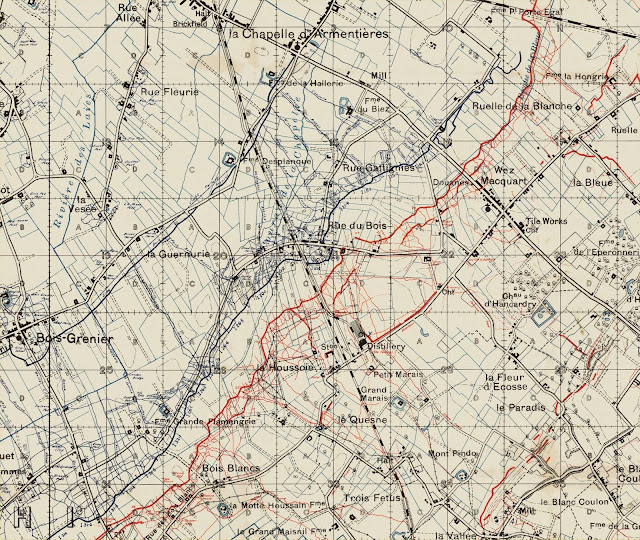The day dawned dull, misty and quiet and remained so all day. In the late afternoon preparations began for the relief of the Battalion, and of the Royal Scots. Baggage and company stores were carried out via Shaftesbury Avenue and company cooks were despatched to new billets in the western fringes of Bois Grenier. Later that evening, having been relieved by 8th Yorkshires, the Royal Scots marched back, via La Rolanderie, to rendezvous with the rest of their Battalion while most of 10DWR made their way to their new billets. By now, however, the village of Bois Grenier, as described by J.B. Priestley, was in ruins,
“a village which must, in the far-off happy days of peace,
have been the home of a prosperous and happy little community. Now – alas – the
civil population have long since gone and the village is a ruin. Some of the
houses are almost intact, while others – the majority – are battered
indescribably. The beautiful old church in the centre of the village is a ruin,
roofless, with only about a quarter of its steeple left”.
 |
| All images by kind permission of Jerry Rendell. They all originate from Capt. H.L. Oakley of 8th Yorkshires; see Jerry's excellent book, Profiles of the First World War |
“a line of reserve trenches runs right through the cemetery,
and our platoon is occupying these trenches. The French graves have all large
stone or wooden crosses on them – mostly 8 to 12 feet in height, and we are
entirely surrounded by these dismal things. Crowded here and there are between
these are little wooden crosses that mark what must be the most pathetic graves
in the world – those of British soldiers. On some of them, little French
memorials have been placed – how and by whom I do not know. At night, our
surroundings look very weird – to put it mildly. But we are veterans now and we
take everything as it comes”. Writing years later he also recalled how, “We had
great crosses and monuments of marble and granite all round us, unbelievable at
night when the darkness was split by the white glare of Very lights and the
shadows were gigantically grotesque, though often we had not time to notice
them, having to duck down as machine gun bullets ricocheted off the funeral
stones”.
Fortunately for Priestley and his pals their stay at
Cemetery Post was only brief and next day they, along with the rest of the
Battalion, would retire to Brigade Reserve at La Rolanderie.
An instruction was issued from the Adjutant General’s Office
in France regarding Pte. Benjamin Wilson
(see 20th December 1915), who
was under treatment at Eaton Hall VAD Hospital, Eaton, Cheshire. He had had his
left leg amputated having been wounded in November. It was now stated that Pte.
Wilson’s wounds were regarded as having been ‘self-inflicted’ and it was now
considered ‘necessary to find out whether he will ver be fit to stand trial by
District General Court Martial’. In the event, there is no evidence that Pte.
Wilson ever appeared before a court martial.
Sgt. Henry Carrodus
(see 9th July 1915) was
formally discharged from the Army, with the award of the Silver War Badge, on
grounds of ill health contracted in service. He had originally served with
10DWR, going to France with the Battalion in August 1915, but, at date unknown,
had transferred to the Northumberland Fusiliers. I am, as yet, unable to make a
positive identification of this man.
69th Brigade War Diary recorded casualties for
the Brigade for the month of January:
Killed 13;
including one officer from 11th West Yorks.
Accidentally killed 0
Died of wounds 7; including two officers; one from 11th
West Yorks and one from 9th Yorks.
Wounded 98;
including three officers; one of whom was 2Lt. Snell (see 30th January).Accidentally wounded 4
Missing 3; including 2Lt. Glover (see 13th January).
10DWR’s casualties were recorded as:
Killed
1
Accidentally killed 0
Died of wounds 0
Wounded
23; including 2Lt. Snell
Accidentally wounded 2
Missing 3; including 2Lt. Glover
The official cumulative casualty figures for the Battalion since arriving in France were now:
Killed
18
Accidentally killed 4Died of wounds 2
Wounded
93
Accidentally wounded
37
Missing 3
The surviving personal effects of the late Pte. John Cardwell (see 27th January) were returned to his family, via the
Infantry Record Office in York.




No comments:
Post a Comment